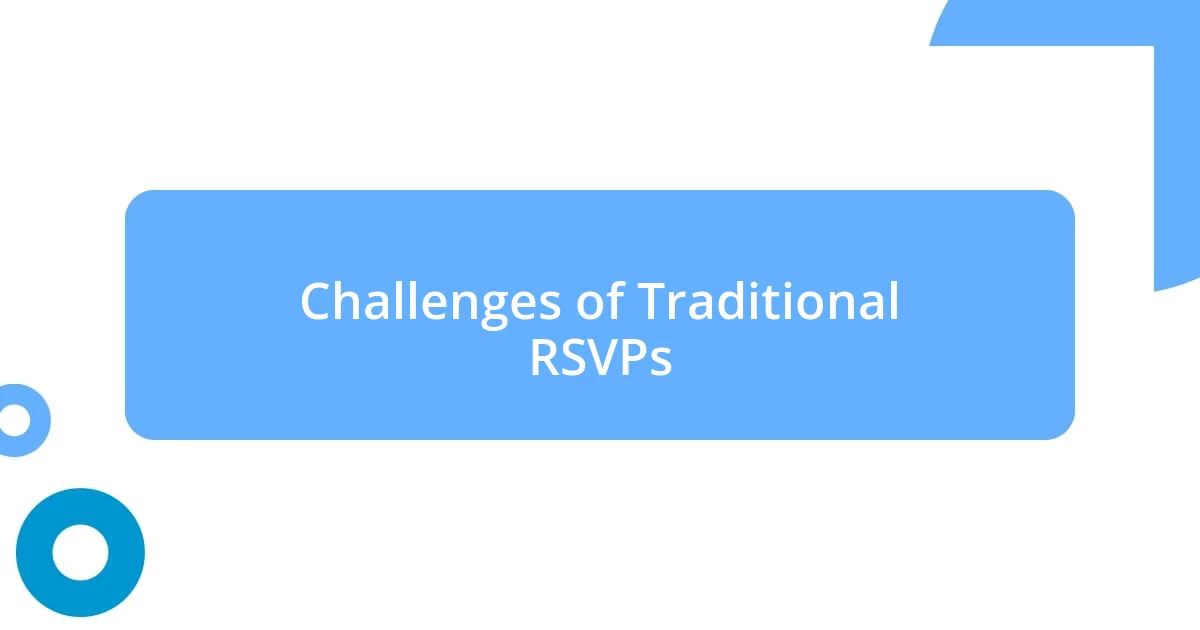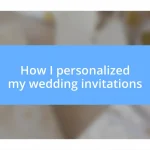Key takeaways:
- Personalize invitations and set clear deadlines to enhance response rates and reduce uncertainty.
- Utilize digital tools and varied response options for easier tracking and engagement from guests.
- Communicate effectively through clear information, timely thank-you notes, and gentle reminders to build connections with attendees.

Understanding the RSVP Process
Understanding the RSVP process can feel daunting, but it really boils down to a few key steps. I remember the first time I organized a gathering; I was overwhelmed by the responses—or lack thereof. Have you ever wondered why some people respond promptly, while others seem to vanish into thin air?
When you send out an invitation, you’re essentially opening a line of communication. It’s about more than just numbers; it’s about sharing your vision for the event. I recall a party where I focused on personal touches in my invites, which surprisingly encouraged more heartfelt responses—people appreciated being thought of individually.
Moreover, setting a clear deadline can help streamline the process. I learned this the hard way when a few friends forgot about my event because they thought they’d reply “later.” That “later” turned into an awkward scramble just days before the gathering! Have you experienced a similar situation? A firm yet friendly reminder can ease that pressure, making the RSVP journey smoother for everyone involved.

Challenges of Traditional RSVPs
When it comes to traditional RSVPs, I’ve faced more than my fair share of hurdles. The lack of immediate feedback can be frustrating, especially when you’re trying to finalize details. There have been times when I needed a headcount for catering, yet some guests would still leave me hanging, turning a joyful planning phase into a stressful guessing game.
Here are some common challenges I’ve encountered with traditional RSVPs:
- Delayed Responses: Friends sometimes take their time, leaving you stuck with uncertainty.
- Miscommunication: Important details can get lost in translation, leading to confusion about the date or venue.
- Lack of Accountability: Some individuals forget to RSVP altogether, which can feel dismissive.
- Outdated Methods: Old-school paper invites can feel impersonal and often don’t encourage timely replies.
- Preferential Treatment: It’s not uncommon to see certain people receive special attention in terms of follow-ups, which can stir feelings of imbalance among guests.
Reflecting on these experiences, I’ve realized that each challenge is an opportunity to rethink how we approach RSVPs. I remember an event where I decided to follow up with a friendly message; it worked wonders, and suddenly, responses came pouring in.

Simplifying Your RSVP Methods
When it comes to simplifying RSVP methods, I’ve found that digital tools can make a world of difference. Instead of relying solely on paper invites, I harnessed platforms like event apps and online forms that made tracking responses a breeze. The first time I did this, I was blown away by the speed and clarity; it felt like the cloud of uncertainty had lifted. Have you ever clicked “send” and then remembered multiple guests who never replied? With these tools, I could see everyone’s status in real-time, and it allowed me to focus on creating memorable experiences, rather than stressing over headcounts.
Another strategy that has worked well for me is to offer diverse response options. I remember one gathering where I included a simple “yes, no, maybe” option in my digital invitation. This seemingly minor addition drastically improved my feedback. Guests felt less pressured to commit right away while still giving me valuable insight into who might attend. It’s interesting how these little tweaks can substantially impact the overall experience. Have you ever observed how people’s busy lives can affect their RSVP habits?
Finally, I believe incorporating a friendly follow-up is key. After sending out invites digitally, I took a moment to send a gentle reminder a week later. I was pleasantly surprised; people responded much quicker when reminded. That personal touch helped create a connection, making the RSVP process feel less transactional and more like a conversation. I think it’s those small, thoughtful gestures that leave a lasting impression.
| RSVP Method | Advantages |
|---|---|
| Traditional Paper Invites | Personal touch; nostalgic feel |
| Digital Invitations | Real-time tracking; eco-friendly |
| RSVP Apps | Instant feedback; user-friendly |
| Follow-up Reminders | Encourages responses; builds connection |

Using Technology for RSVPs
Using technology for RSVPs has truly transformed my planning experience in delightful ways. I vividly recall a birthday party where I used an event management app for the first time. Instead of the usual barrage of text messages and calls, I simply sent a digital invite and watched as guests responded within hours. It was such a relief to see the numbers come through in real-time, leaving me free to focus on the fun details, like a themed cake instead of worrying about who would show up.
Another technique I’ve embraced is the use of multimedia invitations. I remember creating a short video invitation once, where I could express my excitement and include important details in a fun way. The feedback was excellent! Guests appreciated the effort and were more compelled to RSVP. Have you ever thought about how the presentation of an invitation can influence people’s willingness to respond? Using engaging visuals and personal touches really made a difference for me.
And let’s not forget about the convenience of calendar integrations. Once, I synced the digital invites with guests’ calendars, which helped them retain the event in their schedules. I was amazed at how many thanked me for that little nudge. It’s fascinating how integrating simple technology can create a smoother RSVP process while also fostering anticipation for the event. Have you ever noticed how enticing it is when technology simplifies your life, turning planning into pure joy?

Creating a Clear RSVP Template
Creating a clear RSVP template is essential for effective event planning. I once crafted a simple yet comprehensive RSVP form that included fields for contact information, meal preferences, and any special requests. This clarity not only streamlined responses but also made guests feel valued, as if their individual needs were genuinely considered. Have you noticed how a well-structured template can ease confusion and enhance communication?
To make my template even more user-friendly, I added a brief explanation about the event’s purpose and a deadline for responses. This simple addition transformed the way my guests approached their replies. They appreciated having all the necessary information at their fingertips, which made them more likely to respond promptly. Isn’t it interesting how just a few well-placed details can encourage commitment?
Lastly, I ensured that my RSVP template reflected my personality—using colors and fonts that matched the event’s theme. By doing this, I created a visual connection that resonated with my guests. It became more than just a form; it was an invitation to be part of something special. Have you ever thought about how aesthetics in RSVPs can generate excitement and foster a sense of belonging?

Communicating Effectively with Guests
When it comes to communicating effectively with guests, clarity is my guiding star. I remember an event where I sent an initial group email outlining every important detail – date, time, location, and attire. After receiving a handful of follow-up questions that could easily have been answered by that email, I realized just how critical it is to present information in a straightforward manner. Do you find that sometimes just a bit of upfront information can save a world of confusion later?
Another aspect that significantly improved my communication was promptly acknowledging RSVPs. I always make it a point to send a quick thank-you note to guests who reply. It creates an immediate connection and not only reassures them that their response was received but also encourages others to reply with enthusiasm. There’s something about the personal touch of gratitude that makes a guest feel appreciated. Have you experienced how even small gestures can go a long way in building relationships?
Lastly, I’ve learned the importance of following up with a gentle reminder as the event date approaches. On one occasion, I sent out a casual reminder a week before the event, and it worked wonders. Many guests expressed gratitude for the nudge, sharing that life got busy and they had almost forgotten to confirm their attendance. Isn’t it amazing how a simple reminder can show you truly care about their presence, turning a usual RSVP into a warm invitation?

Tips for Stress-Free RSVPs
One of the best tips I can share for stress-free RSVPs is to set a clear deadline. I remember planning a milestone birthday party where I laid out the invitation timeline. By firmly establishing a date for responses, I not only kept my planning on track but also empowered my guests to prioritize their own commitment to the event. Have you ever noticed how deadlines can create a sense of urgency and clarity in decision-making?
In my experience, providing multiple channels for guests to respond can significantly ease the RSVP process. I once created a simple online form alongside traditional email options, which allowed everyone to choose what felt comfortable for them. It was fascinating to see how this flexibility increased my response rate. Doesn’t it feel gratifying when guests have the freedom to choose how they interact with your invitation?
Another effective strategy I’ve found is to personalize follow-ups whenever possible. After sending initial RSVPs, I kept track of who hadn’t replied and sent a friendly text or message. I recall one guest sharing how that nudge made them feel special and appreciated, as though I truly cared about their presence. Have you thought about how small, personalized touches can transform the experience for your guests and make RSVPs feel less like a chore?














